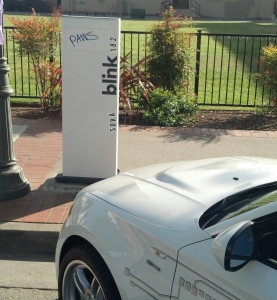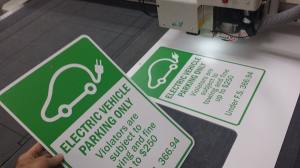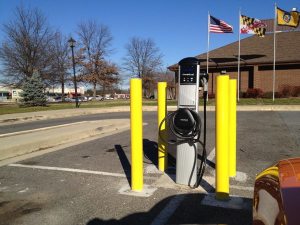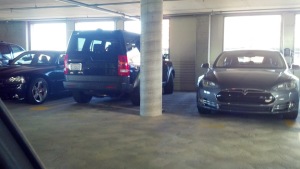The good and the bad in Electric Vehicle Charging Station siting
OK, I am nerding out. I have helped set the new employee charging policy and kicked off my blog about EV ownership and charging. One of the nagging thoughts I keep having is about what would be the utopia of public charging stations? After driving electric vehicles over 80,000 miles over the last 3 years, I have learned a few things about what really makes and breaks a charging location. I’ve seen the good and the bad when it comes to EVSE setup and here are seven of the attributes of what makes a good charging station.
The perfect charging station
- is not close to the entrance
- is easy to find and clearly identifiable
- can easily accommodate all shapes and sizes
- has amenities nearby
- is thoroughly crowd sourced
- isn’t free
- enforced by a consistent set of rules
- The Perfect Charging Station is in a Place Far Far Away
The most important aspect of a charging location is where it is actually located. A prime ‘charging’ spot should not be in a prime ‘parking’ spot. It shouldn’t be by the front door, in a space that is necessarily close to the entrance of a business or close to or shared with a disabled persons parking spot. The charging spot should be further back, less convenient to walk to the front door of the business and closer to the driveway or main entrance of the parking lot for an easier approach to the station. Take for example these chargers at a Target store in Fremont, CA. The setup of these chargers is nearly perfect and contain just about every attribute I look for in a perfect charging location.One of the best attributes is that they are away from the front door of the store and they are easily locatable as soon as you pull into the parking lot. These chargers are located about halfway back from the rear of the parking area. People in non-electric vehicles do not feel as though these spaces are elitist gas cars can park closer to the entrance. The charging signs are also placed fairly high on their posts making them easy to locate as soon as an EV driver pulls into the lot. Many public chargers are not clearly marked. This is particularly an issue when they are provided in a large parking structure. Several years ago, I drove my BMW Active E that had 80 miles of range over 360 miles in one day driving from Santa Cruz to Los Angeles before the days of Superchargers (Actually 1 day before Superchargers, they debuted the week after my trip). The scariest part of my trip was trying to find a charger that was supposed to be in a mall and I couldn’t find it. In the end it turned out it was on the backside of the mall. If chargers are not readily apparent, station owners should have additional signage pointing users to the location of the charger. EV signs with arrows, signs with descriptions (e.g. “EV Chargers are on 2nd Floor”) or assistance by parking attendants are all extremely helpful to first time users. On a surprise trip I planned for my family last year, we went to Disneyland where they had arrows on the parking entrance. Special identification for the vehicle coming in the lot and the attendants were well versed getting me to my space. All the stations were well maintained and in an inconspicuous space so that they would not be easily ICED.
The challenge for business is the installation expense to place the stations in such an optimal space. The stations will require a robust electrical connection and possible trenching to position the charging station correctly. Jim Burness of National Car Charging recommended the following attributes. Spaces should be a limited distance from the power source, the load should be anticipated on the circuit (About 7 kW per level 2 station), considerations for wall or pedestal mounting and to avoid areas prone to flooding. Although charging stations are well protected against shorting out, nobody wants to connect their car while standing in a puddle. Facility planners will have to trade off the location of the charging station with the cost to get it to that position. The long term positive outcome is there will be a lot less frustration policing the stations and greater satisfaction from their EV customers that use the spaces.
The charging station should have a robust connection with the network. When dealing with a networked charger, it will most likely be networked via a 3G or 4G data connection. The station should have a clear signal and not be located on a ground floor or basement or additional expense will be incurred to provide a data connection.
The station location should be expandable. If your location is successful and driving in additional business and satisfaction, the location should be in a space that could convert additional existing parking spaces into charging spaces. Don’t think of these charging spaces as removing parking, they are simply making spaces more functional and will encourage more EV drivers to do business in this location.
- The Perfect Charging Location is Easy to Find
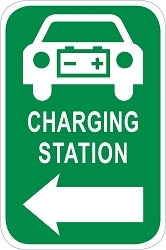 As I had noted about the charging stations at the Fremont Target, the charging stations should be easily identifiable upon entering the property. An EV driver pulling into the Fremont Target lot and can see the green EV Charging signs that are positioned high on their posts, green being a color that is associated with electric vehicles. If the charging station can’t be located in an area that is visible from the parking entrance. Signs pointing to the location are very helpful. If signs are not feasible to direct people, make sure the location noted in the network description giving information on where on the property it is located. Turn by turn descriptions, location on the property, visible attributes. For example “The charging station is located on the southeast corner of the building next to the bank ATM”. Or “It’s on the third floor of the parking structure by the south side stairs”. Branding of the area, of the charger should also be used and the charging stations should be clearly marked. Striping and stenciling should mark the charging spots. Again, green and white colors signify the space has a significant function. Blue should be avoided as it may be confused with a disabled space.
As I had noted about the charging stations at the Fremont Target, the charging stations should be easily identifiable upon entering the property. An EV driver pulling into the Fremont Target lot and can see the green EV Charging signs that are positioned high on their posts, green being a color that is associated with electric vehicles. If the charging station can’t be located in an area that is visible from the parking entrance. Signs pointing to the location are very helpful. If signs are not feasible to direct people, make sure the location noted in the network description giving information on where on the property it is located. Turn by turn descriptions, location on the property, visible attributes. For example “The charging station is located on the southeast corner of the building next to the bank ATM”. Or “It’s on the third floor of the parking structure by the south side stairs”. Branding of the area, of the charger should also be used and the charging stations should be clearly marked. Striping and stenciling should mark the charging spots. Again, green and white colors signify the space has a significant function. Blue should be avoided as it may be confused with a disabled space.
Signage at the charging station is extremely important. The signs need to be concise about the usage of these functional spaces and the consequences violating the rules. The signage needs to alert drivers of internal combustion vehicles that the space is for charging of electric vehicles only. One thing a charging sign should not say is just “EV PARKING ONLY”. The sign needs to alert EV drivers that the charging space is not a preferential parking space. Too many EV drivers do not plug in when they use a charging space or they stay longer than required to charge their car. It’s important that EV drivers move their vehicle as soon as possible and provide contact information if they won’t be able to move it immediately. Signs should indicate a time limit, hours of operation if necessary, civic or vehicle codes if there is a law in the area pertaining to EV charging blocking of spaces. There should be signage stating the minimum fine amount for being parked and not charging and a contact number in case there is a problem with the charging (circuit breaker tripped, unsafe condition, faulty equipment). Signage indicating the location of the space should be mounted high to aid in locating the spot, warnings and special instruction signs should be at eye level.
- The Perfect Charging Station Can Accommodate All Shapes and Sizes
Now that the location and approach is figured out, how the charging station is positioned is very important. If possible, the station should be approachable perpendicularly. Preferably not in a diagonal space. It may be easy for a Nissan Leaf to pull in nose first and have the charge port within a foot of the charging station. However if a Tesla Model S pulls in, the charge port is on the rear left corner of the vehicle. If they pull in nose first and the charging space is diagonal and in the right corner, the cord will need to be over 30 feet long to reach the charge port safely. Chances are the Tesla driver will have to back in against the flow of traffic to charge. Ideally the station should be set up so vehicles can approach from the front or the rear of the station. It can also be ideal to have 4 spots serviced by a dual connector charger in the common corner of the spaces. This can service the most vehicles, but it may be difficult to set and police a charging policy. It’s usually best for charging station user to move their car as soon as possible once their charge is complete. The station should also be well protected from vehicles running into it. Consider installing bollards (short vertical posts) around pedestal mounted stations or wall mounting in a high enough location to avoid bumpers contacting the unit while also being conscious of someone wheel chair bound that may need to operate the station.
The station’s user interface should face the vehicle for easier use and also consider having enough length on the cable to avoid a tripping hazard. A retracting system on the charging station is nice, but tends to have maintenance issues or there should be enough length in the cable so it can drop to the ground, get to the worst-case scenario of the vehicles charge port on the opposite side of the charging space and not be a tripping hazard to get there. This will usually require an extra 5 to 6 feet of cable to do this.
The charger should be covered, especially in areas with inclement weather. Remember your customer will probably spend a minute outside their car activating the station, connecting their car or returning the connector to the station when complete. A little shelter goes a long ways and helps protect the equipment from the elements. Also, it is extremely helpful if more than one charging station is at the location. In the total cost of the project, a second charging station does not necessarily double the cost of the project. You will already be running an electrical line for the 1st station and setting up the identification and provisioning of the system, the variable cost will mostly be the cost of the charging unit. Having more than one unit allows for better usage of the facility and fault tolerance should one of the systems going down there will still be another available. Look at the how Tesla setup supercharging locations. There is a minimum of 6 charging stations at each site to allow for availability, fault tolerance and expansion. Meanwhile the other competing quick charging formats (IEC 62196-3 – DC Charging Combined Charging System (CCS) and CHAdeMO) have received multiple complaints for only having one charging station per location. If a station is blocked or broken, customers can’t charge.
- The Perfect Charging Space Would Accommodate Me Staying a While
Now everything is all set and I can come in and charge. The perfect charging station would be well lit, preferably under a canopy to protect me from the elements and have access to amenities. There would be a restroom available nearby and hopefully a good WiFi signal. Businesses that rely on a captive audience are learning about this. Many casinos are adding chargers to their parking knowing their customer is not going anywhere for a while. Hotels are also learning to add them. Hotels along scenic highways like the Post Ranch Inn in Big Sur or the Best Western Plus at Villa Del Lago along California’s Interstate 5 have created a charging oasis along busy travel routes. Customers of these chargers will probably stay the night or eat at the restaurant at the hotel. Mary Demarest-Paraan, a participant in many Facebook EV groups also recommended a place to buy snacks and useful shopping in the area is helpful. Movie theatres, furniture stores, the DMV and as EV endurance champion Terry Hershner noted with his over 5,000 charging events noted “Even more restaurants!”
Also it would be very helpful someone on shift at a business be trained in the general operation and problem solving of common issues with the charging station and that they know who to contact for more complicated issues. Many times I have run across charging stations where no one on staff knew where the circuit breaker was or who had the access code. Simple instructions could have alleviated this issue. This could be performed by a manger, supervisor, security or a facilities technician.
- The Perfect Charging Station Would Be Thoroughly Crowd Sourced
Once the station is setup and running, it should be added to the network’s website and station apps if it is setup for public use. Disclosure of fees (session fees, time fees, per kilowatt hour fees, penalties for staying over time limit, etc). The station should be listed on crowd source sites, Plugshare, ChargeMap, CarStations, Open Charge Map, Google and manufacturer sites should all include the charging location with as much information as possible. If the site allows uploading of photos, there should be a photo of the station near a reference, and a picture of the stations from the entrance of the location to assist first time users to find the charging station. Also as EV drivers we should let business know that we appreciate the ability to charge and that is the primary reason why we do business with them. If a business added a charging station where that made me switch my business, I also contact the business I left to let them know why. Take for example Walgreen. When they first installed free charging stations at their pharmacies, I switched by prescriptions from the local Target that did not have a charging stations to the local Walgreens that did have a charging station. Now that the Walgreens charges an excessive amount to charge there, I have kept my business Walgreens, but I let them know that I use their drive thru rather than walk into the store where I may have bought other items to avoid the charging fee. Which brings me to my next point…
- The Perfect Charging Station Would Charge Me To Use It
Wait? Why wouldn’t you want a free station? It’s simple, to promote turnover of vehicles using the station and to remove any elitist stigma. Public charging should be for someone really needing a charge (Necessity charging). If there isn’t a cost, then an EV driver will be taking advantage of the free electricity, otherwise known as Opportunity Charging. This leads to some drivers camping on a space. At one location near my house, there is a Nissan Leaf that you will find every day around 5 PM sitting on the free public charger and it will not move until the next morning.
A well setup charging station will have some sort of nominal fee for charging. The business setting up the charger will have to establish what works for them based on their customers demographics. Charge per Kilowatt Hour (kWh) tends to benefit customers with small batteries or slower internal charging acceptance rates such as a Plugin Prius, Chevrolet vehicles, some conversion vehicles. Time based charging is more of a benefit to larger battery and vehicles with higher acceptance rates such as Tesla Model S, Roadster, Toyota Rav4 and Ford Focus. I prefer the time based rates as it encourages turnover of vehicles at sites. Let’s take the Plug In Prius as an example. Suppose the Prius pulls in with an empty 4.4 kWh battery. Let’s say the business considering a $2 an hour rate or a 35 cents per kWh rate and the Prius sits in the space for 5 hours even though it would take only an hour and a half to charge the Toyota. In a charge per kWh scenario, the Prius driver would only be charged $1.75, but at $2 an hour, they would be charged $10 if they stayed 5 hours, or $3 if they moved as soon as they were done. Some business set up features such as the first 2 hours free and $2 an hour after that. An even better policy I have seen is $2 an hour and $10 an hour after 4 hours. This is not to condone excessive charging just to get on the charger, just if the user is exercising poor etiquette when plugged in.
Free charging can work in employee charging situations provided the system is networked. This way the facilitator of employee charging can pull important metrics on who is not following general EV etiquette when plugged in. If they see an owner of a Leaf was plugged in every day for 9 hours, they know they have a problem. This can be done with RFID cards or even with provisioning company badges to the charging station. Having a networked and monitored system helps the company policy police itself. Abuse the system, lose your privilege.
- The Perfect Charging Station Would Be Enforced With Consistent Laws Wherever I Went
Think of what you know about charging in a disabled person’s parking space without a placard? First and foremost you know that it is wrong the wrong thing to do, the parking space serves a function for someone that is disabled. You also know that it is expensive if you get caught, anywhere from $250 to $1000 and with that expense, you know that law enforcement likes to enforce these laws not only for the protection of disabled people’s rights, but also to collect sizeable revenue for their municipality. Now imagine if that same general knowledge and enforcement was applied to charging station spaces. There would be far fewer instances of ICEing and better access to the use of charging stations in public places. The laws may need to be carefully worded to allow for those waiting in queue for a charging station to safely park awaiting the opportunity to charge, but it is all learnable behavior. Just like respecting a disabled person’s space. Consistency in these laws also helps reinforce that notion that these are functional spaces that serve a purpose they are not just preferential spaces. How we get consistent laws will be difficult. Vehicle codes are set by states and enforced by municipalities. Politically active EV drivers need to contact their local and state representatives and ask them to write laws consistent with states like California, Florida, Maryland and Hawaii.
Just like pushing for consistent laws, pushing for these seven attributes should be part of every charging station design. When you visit a station, make sure you check in with the crowd sourcing sites noted in the article and leave a comment on your rating on how they fared in each of these characteristics. If you can work with station owners and let them know how they did and also pass this information along to organizations that advocate additional charging locations in your community. Over time we should see a lot more “perfect” charging stations available.
Did I miss an attribute that you would like to see? Leave them in the comments section below.


